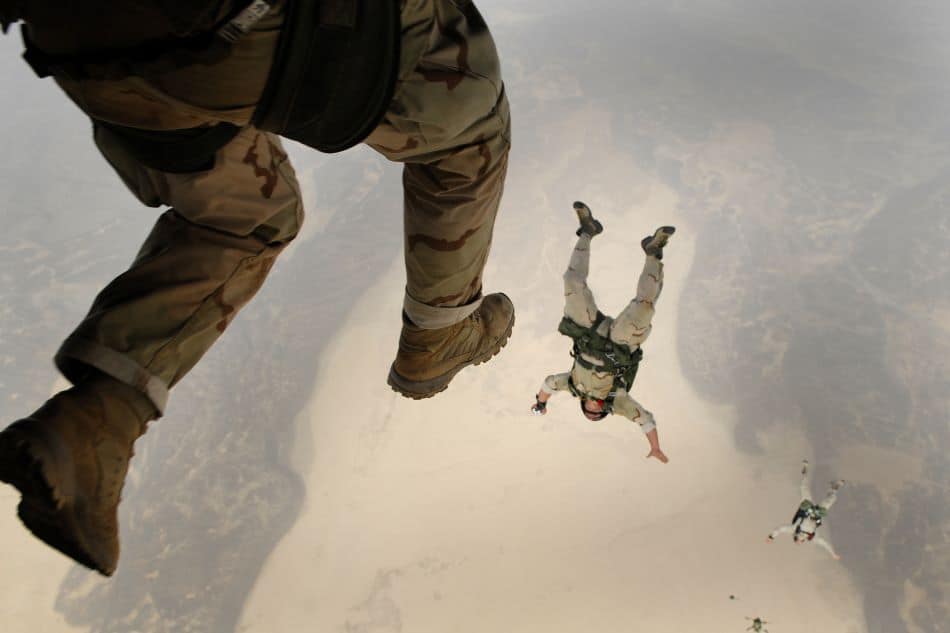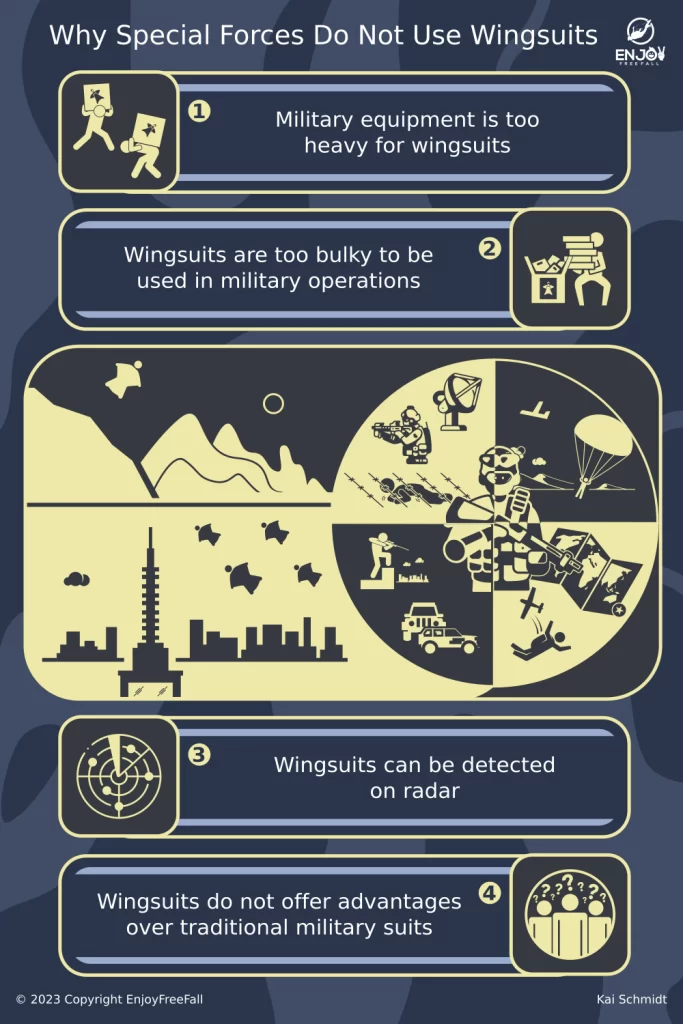
Special Forces are known for their daring operations and unconventional tactics, but do they use wingsuits in their missions and training? Prepare to be surprised by the answer, as it may change your perspective on wingsuit flying.
Special Forces do not use wingsuits in military operations and training because there are no advantages that wingsuits offer over traditional military skydiving suits. Wingsuits cannot carry the weight of military equipment and are too bulky for military operations.
This answer might be surprising to some people. After all, we have watched many movies in which superheroes and special forces use wingsuits to jump from buildings or fly through the air. To clear this myth, I will dig deeper into the reasons why special forces do not use wingsuits and what types of suits they use instead.
The Surprising Reasons Why Special Fores Do Not Use Wingsuits
Military Equipment Is Too Heavy for Wingsuits
The biggest advantage of wingsuits is that they increase the surface area of a skydiver, thereby allowing him to reach a better glide ratio. When a better glide ratio is reached, skydivers can fly greater distances.
However, the glide ratio is mostly determined by the relationship between the surface area and the weight of the skydiver. In military operations, soldiers often carry heavy equipment such as weapons, ammunition, and intelligence equipment.
Due to the weight, the benefits of a larger surface area are offset, resulting in an almost unchanged glide ratio for the wingsuit flyer. In other words, due to the equipment, the soldiers cannot really fly much greater distances with wingsuits.
Wingsuits Are Too Bulky to Be Used In Military Operations
The second reason why wingsuits are not used in military operations is that they are too bulky. This comes in two variations.
Firstly, wingsuits are impractical for soldiers when they have landed as the suits make it difficult for soldiers to move and maneuver quickly. The suits can be dangerous in close-quarters combat and can hinder the use of military equipment, such as weapons and communication devices.
Secondly, it is extremely difficult to fly a wingsuit when carrying military equipment. Equipment such as body armor and backpacks adds bulk to a soldier’s body, hindering their ability to achieve proper body position and maintain control while flying in a wingsuit.
If you’re wondering whether wingsuit flying is difficult to learn and master, my latest post has all the answers. I dive into the intricacies of this adrenaline-fueled activity, exploring the surprising skills and experience required to succeed in the world of wingsuit flying.
Wingsuits Can Be Detected on Radar
Another problem with wingsuits is that they can be picked up by radar. If soldiers using wingsuits are picked up by the radar of enemies, it can have serious implications for their safety and the success of the mission.
The radar system can track their location and movements, making it easier for the enemy to anticipate their actions and respond accordingly.
Additionally, the enemy can use the radar to detect the number of soldiers and their positions, which could potentially jeopardize the mission and put the soldiers at risk.
One of the key advantages of special forces is their ability to remain undetected and swiftly execute missions, often in hostile territory. If they are detected, they might be captured or killed.

Wingsuits Do Not Offer Advantages Over Traditional Military Suits
When considering wingsuits for a military operation, military strategists have to ask themselves: “What are the benefits of using wingsuits? How does it help me achieve my mission? Why is it better than another method?”
All of the questions will be answered negatively. Think about it: Wingsuits are designed to improve the glide ratio and to cover greater distances than traditional skydiving suits. However, due to the military equipment soldiers are not able to cover greater distances with a wingsuit.
This means that the only advantage wingsuits offer in comparison to traditional skydiving suits is taken away.
In addition, there are better options to cover distances. Military aircraft could fly closer to the target destination and drop soldiers there with normal jumpsuits.
In cases, in which military aircraft can not get close enough to the target destination, they will drop soldiers at a higher altitude. The soldiers can deploy their parachutes at a higher altitude and navigate close to the target destination.
If you wonder how far military wingsuit flyers could go, if they were not limited by their equipment. I’ve written an article that reveals the greatest distances ever traveled by wingsuit pilots – trust me, you won’t want to miss it!
What Type of Skydiving Suits Are Used By Soldiers?
As a general rule, soldiers use Military Freefall (MFF) suits, which are designed to meet the unique needs of military operations. These specialized suits are made from fire-resistant materials and have a more streamlined and aerodynamic design, making them ideal for high-altitude operations.
MFF suits are generally used during HAHO (High Altitude High Opening) or HALO (High Altitude Low Opening) operations. Both operation types aim to bring special forces into enemy territory without being detected.
In HAHO jumps, the parachute is deployed at high altitudes, allowing the jumper to glide for a long distance to the drop zone. HAHO jumps are often used when the aircraft cannot get close to the target destination e.g., due to air defense.
In HALO jumps, the parachute is deployed at low altitudes, minimizing the time under the parachute. This helps to avoid detection and special forces can quickly reach the ground. HALO jumps are especially used if enemy troops are active in the dropping area.
That being said, both techniques require extensive training and specialized equipment.
Is the Military Working on Special Wingsuits for Military Applications?
There is no public information about the development of specialized military wingsuits which overcome the limitations of commercial wingsuits. However, the development of military-oriented wingsuits would require such significant alterations that the resulting product could no longer be accurately classified as a wingsuit.
With the advancement of technology, it might come true that see jet-powered wingsuits or ultra-light military equipment, allowing to utilize wingsuits. As of now, however, this remains a theme for movies and myths.


